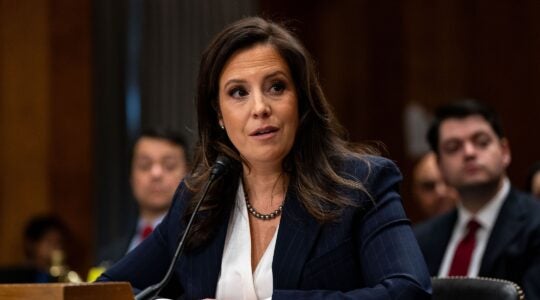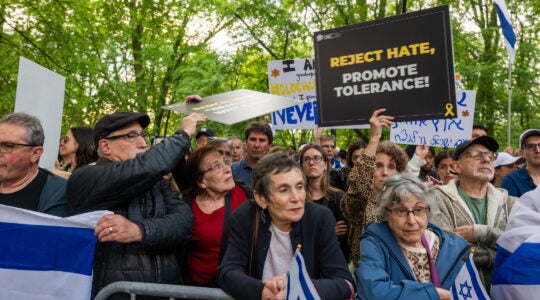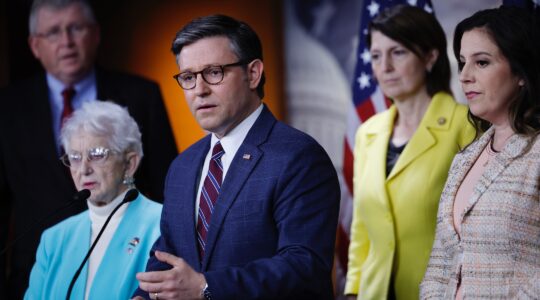NEW YORK (JTA) – Too often the High Holiday process of reflecting on the year gone by can produce a frustratingly vanilla verdict: Not much has changed.
But thanks to Jimmy Carter, gay-friendly rabbis and deep-pocketed donors, the Hebrew year 5767 turned out to be a time of major transition for the American Jewish community.
Arguably the most pronounced and alarming development was the mainstream frontal assault on the pro-Israel activism of Jewish organizations, led by Carter in conjunction with the November release of his book “Palestine: Peace Not Apartheid.”
Published by Simon & Schuster, the book reflects the former president’s longstanding sympathy for the Palestinian cause and belief that Israeli settlements are the main obstacle to peace.
But this time around, in his book and on his book tour, Carter also took aim at the pro-Israel lobby and Jewish organizations, accusing them of conspiring to stifle debate over America’s foreign policy. Plenty of fringe figures have pressed this argument in the past, but suddenly this past year a former president of the United States was leading the charge, with several other respectable figures right behind him.
“This reluctance to criticize any policies of the Israeli government is because of the extraordinary lobbying efforts of the American-Israel Political Action Committee and the absence of any significant contrary voices,” Carter wrote in a Dec. 8 opinion piece in the Los Angeles Times, shortly after the release of his book. He was incorrectly referring to AIPAC, the American Israel Public Affairs Committee.
“It would be almost politically suicidal for members of Congress to espouse a balanced position between Israel and Palestine, to suggest that Israel comply with international law or to speak in defense of justice or human rights for Palestinians.”
Carter was openly supportive of the work of academics Stephen Walt and John Mearsheimer, fellow proponents of the notion that thanks to the efforts of the pro-Israel lobby, Israel does not face scrutiny in the United States even though Jerusalem’s policies are bad for America. The duo, whose own book is set to be released in September, has gone even further than Carter, arguing that the “Israel Lobby” played a lead role – presumably for Jerusalem’s benefit – in pushing America into the Iraq war.
Two other flaps put Jewish organizations on the defensive against the claim that they vigorously work to shut down debate on Israel.
First, in October, after discussions with the Anti-Defamation League and the American Jewish Committee, the Polish consulate in New York pulled the plug on an event sponsored by an outside group that was to feature Tony Judt, a British-born New York University professor who sparked outrage with a 2003 essay criticizing the creation of a Jewish state.
Soon after, Judt created a firestorm with a harshly worded mass email blaming the cancellation on the ADL’s national director, Abraham Foxman. In the end, it appears that Foxman’s office simply inquired to see if the consulate was sponsoring the event (it wasn’t), while the AJC’s executive director, David Harris, pressed for the event to be canceled.
But AJC soon took center stage in a similar controversy, after the organization published an essay by Indiana University professor Alvin Rosenfeld. The essay documented what he described as a rising tide of anti-Israel polemics within “progressive Jewish” thought. In the face of the ensuing brouhaha, the AJC said it was a mistake to include syndicated columnist Richard Cohen in the essay, but otherwise stuck to its guns. The New York Times ran a story painting the essay as an assault on liberals by a “conservative” organization, but subsequently issued a correction, saying it had unfairly characterized the political leanings of the AJC.
The AJC touted the correction, but it seemed a pyrrhic victory, offering temporary solace in the face of a seemingly undeniable trend: Respectable voices in the wider society increasingly view Jewish organizations as parochial interest groups rather than standard-bearers of a moral cause.
Less jarring, but nonetheless symbolically important, was the community’s highest-profile religious development of the year: the December decision by the Conservative movement’s top lawmaking body to permit the ordination of gay and lesbian rabbis as well as the performance of same-sex ceremonies.
The movement’s West Coast seminary, moved quickly to open its doors to gay and lesbian rabbinical students, with the Jewish Theological Seminary of America in New York following suit in March.
A few of the more traditionalist members of the Law Committee resigned, and voices of opposition were heard in branches of the movement in other countries. But the decision sparked little controversy in Conservative synagogues across the United States, especially compared to the tense fallout from the movement’s decision more than two decades ago to ordain women.
While only a small number of rabbis and congregations were vocally upset over the decision, few people are likely to benefit directly from it.
Instead, the new policy carries tremendous symbolic importance, most notably in how it punctuates a decades-long shift in the religious landscape of Jewish life in America. Throughout much of the 20th century, Conservative leaders viewed their movement as an ideological and sociological middle ground between the respective extremes of the Reform and the Orthodox.
But the decision to drop the ban on gay ordination and same-sex unions provides a powerful confirmation that the bridge connecting the denominations is crumbling, leaving a widening gap between Orthodoxy and everything else.
The question going forward is no longer whether Conservative Judaism will hold the center, but whether it will win, or at least not lose any more ground, in the battle with the Reform movement for the hearts and minds of the vast majority of American Jews who fall on the liberal side of the divide with the Orthodox.
Just as 5767 highlighted the changing denominational map, this past year saw a string of moves that reflected the diminishing dominance of local Jewish charitable federations and their national arm, the United Jewish Communities. For several decades the federation movement was the unchallenged force in determining the community’s spending priorities.
But in recent years mega donors and private foundations have often taken the lead – and several developments this year suggest that this trend will only intensify.
The year started out with a big bang: Yeshiva University announced that its immediate past chairman, fertilizer and oil magnate Ronald Stanton, was giving $100 million to the school – believed to be the most amount of money ever pledged to a Jewish cause.
“I’m sorry that this is the largest gift ever” to a Jewish organization, Stanton said. “There are plenty of people who could do it, but most substantial philanthropy goes to non-Jewish causes.”
Other donors made news, including William Davidson, owner of the Detroit Pistons and president of Guardian Industries Corp. of Auburn Hills, Mich., and his wife, Karen, who pledged $75 million for a new inpatient tower at Hadassah’s Jerusalem hospital.
Though not as lavish, two $15 million pledges were significant in terms of underscoring the lead role that private family foundations are playing. One of the pledges was from The Charles and Lynn Schusterman Family Foundation to Brandeis for the creation of an interdisciplinary Israel curriculum, at a time when Jewish students and communal officials are grappling with anti-Israel sentiment on campus and Arab-funded Middle Eastern studies programs are growing.
The other $15 million pledge – from the Harry and Jeanette Weinberg Foundation to help cover tuition costs at 12 Jewish day schools in Baltimore – was cheered by Jewish education advocates as a potential philanthropic model for tackling the major financial challenges face by day schools.
Fifteen million dollars was also the magic number for the Foundation for Jewish Camping, which received an anonymous donation of that amount from a donor in Chicago. In addition, the camping outfit scored an $11.2 million grant from the Jim Joseph Foundation for preteens in communities West of the Rockies – the splashiest yet as it moves forward with plans to give away $25 million annually.
This would be enough for any year, but 5767 marked the opening of the foundation of casino mogul Sheldon Adelson and his wife Miriam. The couple are reportedly planning to dole out $200 million a year to Jewish causes – dwarfing the amount raised annually by any local federation except for New York.
The Adelsons pledged $60 million this year to birthright israel, and gave $4.5 million to the Shalem Center in Jerusalem for a star-studded institute that will seek to deal with issues facing Israel and Western civilization including nationalism, terrorism, identity and the spreading of human rights and democracy.
The UJC is not standing still. It passed a $40.2 million budget, allocating a significant portion to a restructuring plan aimed at boosting the sagging annual campaigns of local federations; the plan also seeks to build on the success of the UJC’s $360 million Israel Emergency Campaign by beefing up the organization’s office in Israel.
Federations also are working to adapt to the changing philanthropic universe, where individual donors and foundations have the ability to give more in a year than entire communities raise in their annual fund-raising campaigns.
Many – like the Baltimore federation, which is giving $1 million per year to day schools in conjunction with the Weinberg foundation – are seeking to leverage their expertise and influence to forge partnerships with these independent players. Similar efforts are under way in cities such as Boston and Chicago, where federations are working with outside donors to develop innovative approaches to funding Jewish education.
In general – from political activism to religion to philanthropy – the past year demonstrated that the rules of the game are changing dramatically, often rapidly. Looking ahead, the question is which individuals, institutions and movements will figure out how to adjust.
JTA has documented Jewish history in real-time for over a century. Keep our journalism strong by joining us in supporting independent, award-winning reporting.





